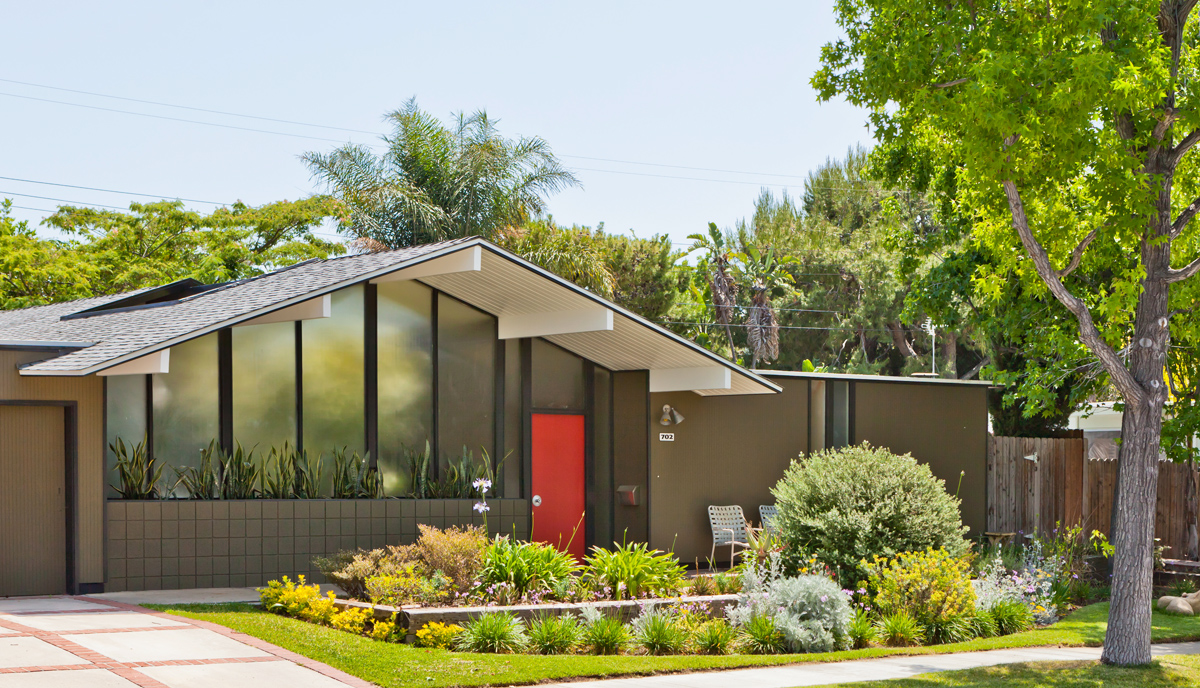Experiment in Innovation - Page 2
 |
|
|
 |
|
an estimated 5,000 homes. |
The five-bedroom, 2,700-square-foot home has one of Eichler's tallest ceilings, soaring to a ridge 18 feet above the floor. "It certainly is the tallest I've seen," says Couris, a Marin real estate agent.
But it's not just the drama of the house, or of its view over Richardson Bay towards Sausalito and San Francisco that makes it special. Couris, who's lived there 40 years and raised a daughter in the house, appreciates its livability.
"As regards to the actual layout of the house, I think it's perfect," she says. "I wouldn't change a thing."
In Walnut Grove, a small Eichler tract from the late 1960s and early 1970s in Walnut Creek, one of the most popular models is the W-14, which takes on a slightly medieval look thanks to a clipped, or hip-roof-like, gable front.
Scott Brignoni and Scott Turner, who inhabit one in the neighborhood, appreciate it less for evoking the past than for its arrangement of spaces, views, and quality of light.
In plan the home resembles the HPO-15—but with differences that suggest the variety of these late Oakland models.
Rather than a bedroom bordering the living-dining room, for example, Brignoni and Turner's home has a covered patio there instead, an outdoor area that seems like an al fresco room, bringing additional light and air into living areas and kitchen, and providing an ideal spot for sheltered outdoor relaxing and dining.
"One of best things about this model is the height," Turner says, noting that you can stand in the living room and look out through the front clerestory at palm trees three blocks away.
The couple also appreciate that the bedrooms are separated from the living areas. "You can have a lot going on out here" in the living area, Brignoni says, "and be in the bedrooms and not know what's going on."
Along with Harbor Point and Los Altos' Fallen Leaf Park, Walnut Grove was one of Oakland's favorite neighborhoods, places where he created not just individual homes, but striking and livable ensembles.
It's not surprising that by 1969, the year Brignoni and Turner's house was built, Oakland knew how to design delightful suburban dwellings and neighborhoods.
According to an interview with the late architect Kinji Imada, Oakland's close friend and chief associate in his firm, Oakland's involvement with Eichler homes began with the first model Anshen and Allen produced, the AA-1, then never let up.
In fact, Steve Allen, Anshen's partner, in effect conceded that Oakland had from his start at Anshen and Allen been the main Eichler designer. When Oakland successfully sought to be named a Fellow of the American Institute of Architects in 1979, his application stated he'd been principal designer since 1950. Allen, his sponsor, signed off on the application.
But Oakland (1919-1989) never gained the fame that history has bestowed upon Eichler's two other main architects. He "was not one who did anything to publicize himself," Imada has said.
"Bob [Anshen] was a showman," the late architect August Rath, who worked with Oakland at Anshen and Allen, recalled years later. "Claude was not a showman."
A taskmaster in the studio, Oakland was a civil rights advocate, marched against the Vietnamese War, played the grand piano, was well dressed, moody at times, and was kindly disposed to let spiders take up abode in his home. "Every time I think of Claude," recalled Rath, "I see a warm, loving face."
During the latter years of Eichler's homebuilding business, after his first firm, Eichler Homes, went bankrupt in 1966 and he continued building through a series of smaller firms—J. L. Eichler Associates, Nonpareil Homes, Alsco Homes—Eichler continued to work continuously with Oakland.
About Oakland, Eichler wrote in a brochure for Nonpareil Homes, "Ours is an architect-client relationship rather than employer-employee.




